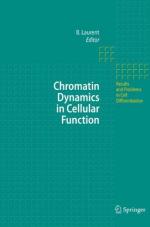|
This section contains 307 words (approx. 2 pages at 300 words per page) |
Chromatin is a network of deoxyribonucleic acid (DNA) and nucleoproteins that constitutes a chromosome. Chromatin can only be found in a cell with a nucleus and is therefore not present in a prokaryotic cell. The DNA within a eukaryotic cell can be as long as 12 cm (4.7 in). Due to its length, the DNA must be arranged and organized in order to fit within the small area of a cell nucleus. To accomplish this task, the DNA is bound, through electrostatic forces, with nucleoproteins called histones and nonhistones. The assemblage of DNA with the nucleoproteins is called a nucleosome, which is the fundamental structural unit of chromatin and represents 1.8 turns of DNA wound around a core particle of another histone protein. It is the nucleosomes, along with the DNA material between nucleosomes (linker segment), that gives DNA the characteristic beads-on-a string appearance, with the nucleosomes representing the bead and the linker segment of DNA representing the string.
When chromatin is isolated, it appears to be composed as smooth fibers. While the highest level of chromatin organization is not well understood, scientists have found that chromatin fibers are divided into functional groups, called domains. The domains are grouped and arranged into loops called solenoids. In cells that are dividing, the solenoids are further condensed into chromatids; an identical pair of chromatids comprise the recognizable shape of a chromosome.
There are two types of chromatin: heterochromatin and euchromatin. Heterochromatin is chromatin in condensed form, is seen as dense patches and is transcriptionally inactive while euchromatin is seen as delicate, thread-like structures that are abundant in active transcription cells.
When early scientists began staining cells, they noticed that granular material within the nucleus could become brightly colored when stained with a basic dye. The colored granular structures were named chromatin, derived from the Greek word khroma, which means color.
|
This section contains 307 words (approx. 2 pages at 300 words per page) |


